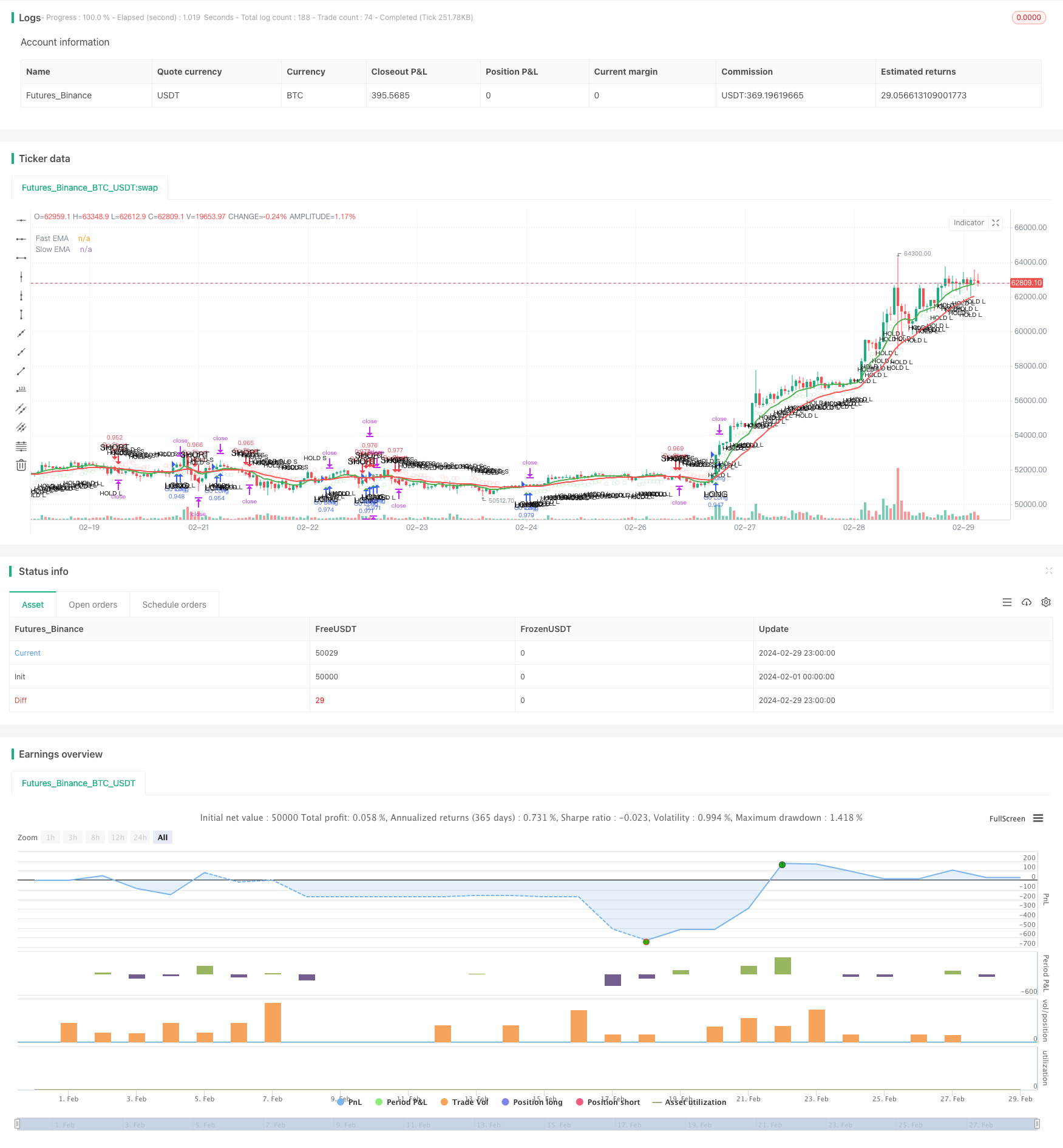
概述
动量均线交叉策略是一种基于两条移动平均线交叉的交易策略。该策略使用快速移动平均线(快线)和慢速移动平均线(慢线)来捕捉市场的动量变化。当快线从下方向上穿越慢线时,产生做多信号;当快线从上方向下穿越慢线时,产生做空信号。该策略同时考虑了趋势持续条件、止损和止盈,以控制风险和优化收益。
策略原理
该策略的核心原理是利用两条不同周期的指数移动平均线(EMA)来判断市场趋势和动量。具体步骤如下:
- 计算快速EMA(本例中为9日)和慢速EMA(本例中为21日)。
- 当快速EMA从下方向上穿越慢速EMA时,产生做多信号;反之,当快速EMA从上方向下穿越慢速EMA时,产生做空信号。
- 为了确认趋势持续,策略还设置了持仓条件:做多持仓时,要求快速EMA在慢速EMA上方,且收盘价在快速EMA上方;做空持仓时,要求快速EMA在慢速EMA下方,且收盘价在快速EMA下方。
- 为了控制风险,策略使用平均真实波动范围(ATR)来判断市场波动性,当快速EMA和慢速EMA之间的差值小于ATR时,策略不进行新的开仓。
- 策略同时设置了止损(1%)和止盈(2%),以固定百分比的方式进行风险控制。
通过以上原理,该策略能够根据市场趋势和动量变化进行交易决策,同时考虑了趋势持续性、市场波动性和风险控制等因素。
优势分析
动量均线交叉策略具有以下优势:
- 趋势跟踪:通过快慢均线的交叉,策略能够及时捕捉市场趋势的变化,适应不同的市场环境。
- 简单易用:策略逻辑清晰,仅依赖于价格和均线指标,易于理解和实现。
- 风险控制:策略设置了止损和止盈,以固定百分比的方式控制单笔交易的风险敞口。
- 趋势确认:策略不仅考虑了均线交叉,还引入了趋势持续条件,以确保开仓时趋势的延续性。
- 波动性过滤:通过比较均线差值和ATR,策略可以在市场波动较小时避免开仓,降低交易频率和风险。
风险分析
尽管动量均线交叉策略有其优势,但仍存在一些风险:
- 延迟风险:均线是滞后指标,可能在趋势反转后才产生信号,导致错失最佳入场时机或承受更大的回撤。
- 振荡市风险:在振荡市场中,快慢均线可能频繁交叉,产生多次假信号,导致频繁交易和损失。
- 参数风险:策略的表现依赖于均线周期和止损止盈的设置,不同参数可能导致不同的结果。
- 黑天鹅风险:策略基于历史数据,可能无法应对极端市场事件或异常波动,导致重大损失。
为了应对这些风险,可以考虑以下方法:
- 结合其他指标或信号,如价格行为、交易量等,以提高信号的可靠性。
- 在振荡市中引入过滤机制,如ATR或ADX,以避免频繁交易。
- 对参数进行优化和测试,选择历史表现稳定的参数组合。
- 设置合理的风险控制措施,如仓位管理、总体止损等,以应对极端市场状况。
优化方向
为了进一步提升动量均线交叉策略的性能,可以考虑以下优化方向:
- 动态参数优化:根据市场状况动态调整均线周期和止损止盈参数,以适应不同的市场节奏和波动率。这样可以提高策略的适应性和稳健性。
- 多时间框架分析:结合不同时间框架的均线信号,如日线和小时线,以获得更全面的趋势判断,并根据不同时间框架的信号强度分配仓位。
- 组合其他技术指标:引入其他技术指标,如MACD、RSI等,以提供更多的交易信号验证,提高信号的可靠性。
- 风险管理优化:采用更高级的风险管理方法,如凯利公式或动态仓位管理,以优化资金配置和控制回撤风险。
- 机器学习优化:应用机器学习算法,如遗传算法或神经网络,对策略参数和逻辑进行优化,寻找最佳的参数组合和交易规则。
通过以上优化方向,动量均线交叉策略可以在保持原有优势的基础上,提高适应性、稳健性和收益潜力,更好地应对不同市场环境的挑战。
总结
动量均线交叉策略是一种简单而有效的交易策略,通过快慢均线的交叉来捕捉市场趋势和动量变化。该策略具有趋势跟踪、简单易用、风险控制等优势,同时也考虑了趋势持续性和市场波动性。但是,该策略也面临延迟风险、振荡市风险、参数风险和黑天鹅风险等挑战。为了应对这些风险并进一步提升策略性能,可以考虑动态参数优化、多时间框架分析、组合其他技术指标、风险管理优化和机器学习优化等方向。通过不断优化和改进,动量均线交叉策略可以成为一种更加稳健和有效的交易工具,帮助交易者在不同市场环境中获取稳定的收益。
策略源码
/*backtest
start: 2024-02-01 00:00:00
end: 2024-02-29 23:59:59
period: 1h
basePeriod: 15m
exchanges: [{"eid":"Futures_Binance","currency":"BTC_USDT"}]
*/
//@version=4
strategy("Enhanced Momentum Bot", shorttitle="EMB", overlay=true, default_qty_type=strategy.percent_of_equity, default_qty_value=100)
// Define the Exponential Moving Averages (EMA)
fastEMA = ema(close, 9)
slowEMA = ema(close, 21)
// Plot EMAs for trend visualization
plot(fastEMA, color=color.green, title="Fast EMA", linewidth=2)
plot(slowEMA, color=color.red, title="Slow EMA", linewidth=2)
// Entry Conditions
longCondition = crossover(fastEMA, slowEMA)
shortCondition = crossunder(fastEMA, slowEMA)
// Define conditions for holding or not entering
// Pseudo-conditions to illustrate logic - Adjust according to strategy specifics
holdLongCondition = fastEMA > slowEMA and close > fastEMA
holdShortCondition = fastEMA < slowEMA and close < fastEMA
dontEnterCondition = abs(fastEMA - slowEMA) < atr(14) // Using ATR as a measure of volatility
// Signal plotting for clarity
plotshape(series=longCondition, title="Long Entry", location=location.belowbar, color=color.green, style=shape.triangleup, text="LONG")
plotshape(series=shortCondition, title="Short Entry", location=location.abovebar, color=color.red, style=shape.triangledown, text="SHORT")
// Hold signals - less emphasized
plotshape(series=holdLongCondition, title="Hold Long", location=location.belowbar, color=color.new(color.green, 80), style=shape.circle, text="HOLD L", size=size.tiny)
plotshape(series=holdShortCondition, title="Hold Short", location=location.abovebar, color=color.new(color.red, 80), style=shape.circle, text="HOLD S", size=size.tiny)
// Don't Enter - caution signal
plotshape(series=dontEnterCondition, title="Don't Enter", location=location.absolute, color=color.blue, style=shape.xcross, text="WAIT")
// Define Stop Loss and Take Profit as a percentage of the entry price
stopLossPercent = 0.01 // 1%
takeProfitPercent = 0.02 // 2%
// Execute Trade on Conditions
if (longCondition)
strategy.entry("Go Long", strategy.long)
strategy.exit("Close Long", "Go Long", loss=stopLossPercent * close, profit=takeProfitPercent * close)
if (shortCondition)
strategy.entry("Go Short", strategy.short)
strategy.exit("Close Short", "Go Short", loss=stopLossPercent * close, profit=takeProfitPercent * close)